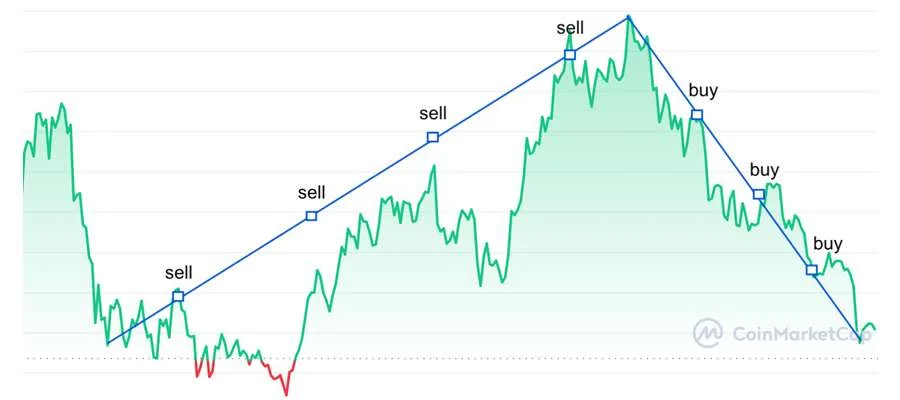Kraken

- Buy, sell and trade 222 cryptos.
- Instant funding & advanced trading options.
- Join 9M+ users around the world.
Whether or not you’re reading this in January 2022, there will always be another dip. How one reacts to a sudden drop in the cryptocurrency market can make or break a trading strategy. Pro traders prepare for exactly this sort of scenario, as properly capitalizing on them can be extremely profitable. As Warren Buffett puts it best, “be greedy when others are fearful, and fearful when others are greedy”.
In other words, when other traders are dumping their bags, it may be the time to deploy that cache of fiat you’ve been saving up. This article explores how, and why pro traders decide to buy the dip.
There are at least three reasons pro traders decide to fill their bags during a market downturn. Traders use these reasons as motivation to be patient and execute their strategy carefully.
The first reason to buy the dip is that buying when the market is at a relative low means that they get more bang for their buck. They get to accumulate more units of the cryptocurrency for the same amount of fiat. Pro traders wait for downturns because they want to buy as close to the bottom of the market as they can, maximizing the amount of cryptocurrency they add to their portfolio. This is so they end up with more, or so that they maximize profits from selling the cryptocurrencies later at a market high.
The market may simply be reacting to news or political events. If nothing is happening elsewhere in the world, yet the market is reacting, pro traders tend to see right through this and take the downturn as a buying opportunity. If nothing has actually changed that would affect the cryptocurrency in question, then chances are that the market is just panic selling, or “selling the news”.
A strategy employed by pro traders is swing trading. That is, identifying a sudden move in the market that is likely to then rebound in the other direction. Not every dip is an opportunity to swing trade, but some pro traders can read the signals. If they predict the market correctly, they can buy the dip and sell in the corresponding relief rally that brings the market back up.” aria-label=”table” src=”https://datawrapper.dwcdn.net/VTSZU/103/” scrolling=”no”]
After having covered why and when pro traders might buy the dip, we are free to look into how pro traders actually pull off buying the dip as a strategic move. The first, but maybe not so obvious thing to mention, is that pro traders are prepared to buy the dip. They have already signed up, and deposited funds onto a cryptocurrency exchange ahead of time. If you’ve not already done so, check out Finder’s list of cryptocurrency exchanges.
Pro traders tend to keep a reserve of cash specifically for market downturns. This requires a high level of patience as it can be tempting for novice traders to go “all in” on a cryptocurrency in the short term. Pro traders tend to wait for signals that tell them that a particular time is the optimal time to deploy the reserves of cash they’ve been saving.
One way that pro traders accumulate, deploy, then re-accumulate that reserve of cash is by selling into market strength, and buying into market weakness. Put another way, selling when the market is going up, and buying when the market is on the way down. This is otherwise known as dollar cost averaging in and out of the market. Their cash reserves would slowly go up when the market is rising, and slowly go back down when the market is decreasing. Then, if there is an aggressive move in the downward direction (“a dip”), the trader can make a judgment call as to whether or not it is a good time to use the rest of their cash reserves.

This brings us to the next point. How do pro traders know where the bottom of the market is? The short answer is they don’t, no one does. At the end of the day, no one can predict the market. This is why pro traders use strategies like dollar cost averaging so they can get the best average price within a dip, rather than buying the absolute bottom.
Buying the dip doesn’t always work out. Sometimes, the dip keeps on dipping. This means that traders buy the dip, then the market goes even lower. Pro traders might set a stop loss in order to prevent them from totally committing fully to any particular dip. If they continue to buy the dip with stop losses, then eventually they will buy the lowest dip of a series of down movements. Novice traders might empty their cash reserves on the first of a series of dips, and not set stop losses, only to be left without any more capital to buy in at lower prices.
Buying the dip is not as simple as twitter makes it sound. Pro traders use a range of strategies while buying during a market downturn. How you invest during the red days depends a lot on how you invest during the green days. At the end of the day, pro traders set rules for themselves and tend to have conviction in the execution of those rules. Impulsive and emotional investing is just the sort of thing that gets traders wrecked during periods of high volatility. So, if considering “buying the dip”, remember there might be more dip than you’re anticipating.
Get ready for your next crypto opportunity by using our table to quickly compare crypto exchanges on fees, fiat currencies, deposit methods and more. Once you’ve found the right fit for you click Go to site to get started.
To make comparing even easier we came up with the Finder Score. Supported coins, account fees and features across 28 cryptocurrency trading platforms are all weighted and scaled to produce a score out of 10. The higher the score the better the exchange - simple.
Find out how day trading crypto works, and compare our picks for the best crypto day trading platform in Canada.
Crypto ETFs let you invest in bitcoin and other cryptos—often with less risk than buying crypto directly. Learn more in our guide.
Your detailed guide to cryptocurrency trading bots, how they work and the benefits and risks you need to consider when choosing a crypto trading bot.
There’s much to gain and lose in the volatile cryptocurrency market. If you want to make the best decisions, then you need to understand how to do a technical analysis. This guide from finder will tell you everything you need to know.
Read our beginner’s guide to cryptocurrency arbitrage, how it can help you take advantage of crypto price differences and the risks you need to be aware of before you start trading.